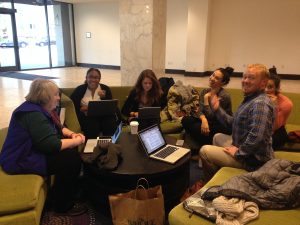DPMI Client Project with Grameen Foundation, 2017
I had the privilege of spending my Spring Break ’17 in DC with six other MIIS students in the Development Practice & Policy Program alongside Dr. Beryl Levinger. We engaged in a week-long client project with one of three leading international organizations: FHI 360, Root Change, and the Grameen Foundation. Our consultancy focused on various areas related to program design, management, and monitoring and evaluation. This hands-on practicum complemented our three-week Design, Partnering, Management, and Innovation (DPMI) Certificate training. There was an additional pre-workshop on managing project development with Dr. Levinger prior to the practicum, which helped reinforce essential tools and frameworks needed to support the projects. We split into three teams and reconvened at the end of each day with Dr. Levinger to discuss our projects, exchange ideas, and debrief on the learning experience. Dr. Levinger supported us throughout the week by offering guidance at our debrief sessions and spending several hours at each site during the workday.
Being placed on the Grameen team offered me the opportunity and challenge of tackling the ever-complex issue of monitoring and evaluation (M&E) across a giant international development organization that had just integrated with Freedom from Hunger, another giant in the field. We were tasked with the goal of developing a set of options for Grameen to consider when making decisions regarding how to define beneficiaries for its programs going forward, how they will be counted and for how long they should be tracked. What may sound like a simple task was, by no means, an easy feat. In fact, monitoring and evaluating the impact and explaining a set of outreach numbers to stakeholders across the spectrum with varying interests and accountabilities has never been and will never be easy. I’ve worked on impact assessments in the past with organizations like Habitat for Humanity, but working with a new Grameen was a unique case. It became incredibly evident to me how tiresome and cumbersome M&E can be in especially large international organizations that are highly dependent on its funders.
Communication and leadership became particularly salient during our stakeholder interviews, documents/systems review, and our findings and interpretations presentation. Stakeholder inclusion and engagement, leadership decision-making, arriving at an organization-wide consensus on measuring outreach and overall tracking philosophies and methodologies, and communicating these decisions and processes to a wide audience from partners and program directors to donors and the public are all crucial components to the overall sustainability of the organization and its programs. These aspects had a profound impact on me both personally and professionally.
For each of these objectives, there were a series of important issues we had to consider when understanding the ways each organization historically defined, counted, and tracked beneficiaries in order to eventually offer a set of recommendations. For example, Grameen runs on a business-to-business model where they rely on their partners for outreach data. They also have joint ventures and wholly-owned subsidiaries such as Taroworks, Bankers without Borders, Grameen Foundation India that complicate counting even further. Freedom from Hunger tracks projects sometimes for more than 20 years even after the program cycle, whereas old Grameen stops tracking once the program cycle ends. CSRs v.s. QPRs, Excel v.s. Salesforce – the list goes on. This seemingly impossible task of streamlining an integrated approach moving forward is very possible and time-consuming, but it needs to happen for clear and coherent messaging and relationship building across the organization and its partners. And, it is happening. I was very pleased with the way we carried out our surveys and interviews, our analysis and future recommendations. It initiated a larger conversation that the organization already knew needed to happen. Our research was able to reinforce the necessity of setting aside some time to get together in real time to view and discuss the data we had collected and make informed decisions.
An incredibly valuable and intense experience, I learned a whole lot about the Grameen Foundation and beneficiary counting on a large scale in a week’s time. For me, brief consultancies that are highly immersive and experiential like the DPMI Client Project are the best way take a deep dive into the organizational culture and practical training in one’s field of interest. I would highly recommend doing this week-long practicum to future candidates.
 This a group shot of our meeting debrief with Dr. Levinger. This is the only photo I have of the entire group throughout the entire duration of the project. We were so busy with the project itself that we could barely think about taking photos.
This a group shot of our meeting debrief with Dr. Levinger. This is the only photo I have of the entire group throughout the entire duration of the project. We were so busy with the project itself that we could barely think about taking photos.
Back to DC Page



You must be logged in to post a comment.